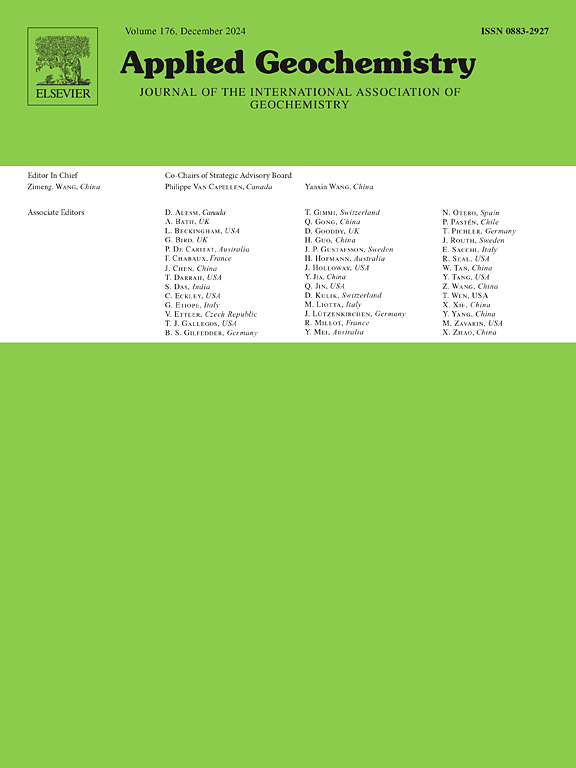红色裂纹牛肝菌系统--土壤中镁-铜-锌同位素特征的长期变化
IF 3.4
3区 地球科学
Q1 GEOCHEMISTRY & GEOPHYSICS
引用次数: 0
摘要
研究了连续两个生长季节在花岗岩、角闪岩和蛇纹岩基岩下三个地点采集的干菇样品的Mg-Cu-Zn同位素系统。在蘑菇中分析的元素(Mg, Cu, Zn)在浓度上没有位点依赖性。土壤δ65Cu值的变化范围很广(−0.85 ~ +0.67‰),δ26Mg同位素(δ26Mg =−0.78 ~−0.30‰)均处于亏缺状态。花岗岩样地土壤的δ66Zn值大多为负(- 0.33 ~ +0.07‰),角闪岩样地土壤的δ66Zn值为正(+0.03 ~ +0.12‰),蛇纹岩样地土壤的δ66Zn值仅略偏离零(- 0.09 ~ +0.09‰)。观察到的含菌土壤和无菌土壤同位素组成的差异很可能是由于含菌土壤中存在蘑菇菌丝体所致。Mg、Cu和Zn的同位素在蘑菇的吸收和内部转运过程中都有不同程度的分异。蘑菇对同位素轻Mg (Δ26MgFB-soil =−0.71 ~−0.12‰)、同位素重Zn (Δ66ZnFB-soil = 0.61 ~ 0.91‰)和同位素可变Cu (Δ65CuFB-soil =−1.22 ~ +1.03‰)的吸收率较高。菌内同位素分馏范围显著,Δ26Mg总范围为1.09‰;Δ65Cu, 0.65‰;Δ66Zn为0.38‰。对于所研究的任何元素,没有观察到蘑菇内同位素分馏的统一方案。本文章由计算机程序翻译,如有差异,请以英文原文为准。
Changes in Mg-Cu-Zn isotopic features in a system red cracking bolete – soil over an extended period
We studied Mg–Cu–Zn isotope systematics of the Xerocomellus chrysenteron mushroom samples collected during two consecutive growing seasons from three sites underlain by granite, amphibolite, and serpentinite bedrock. None of the elements analyzed in mushrooms (Mg, Cu, Zn) displayed site-dependency in concentrations. The studied soils were depleted in 26Mg isotope (δ26Mg = −0.78 to −0.30‰) and displayed a very wide range of δ65Cu values (−0.85 to +0.67‰). Values of δ66Zn were mostly negative for soils from the granite-based site (−0.33 to +0.07‰), positive for soils from the amphibolite-based site (+0.03 to +0.12‰), and only slightly deviated from zero for soils from the serpentinite-based site (−0.09 to +0.09‰). Observed difference in isotope compositions between the mushroom-bearing and mushroom-free soils was most likely due to the presence of mushroom's mycelium in the mushroom-bearing soils. Isotopes of Mg, Cu, and Zn fractionated to different extent during both uptake and within-mushroom translocation. Mushrooms displayed higher uptake of isotopically light Mg (Δ26MgFB-soil = −0.71 to −0.12‰), isotopically heavy Zn (Δ66ZnFB-soil = 0.61–0.91‰), and isotopically variable Cu (Δ65CuFB-soil = −1.22 to +1.03‰). The ranges of the within-mushroom isotope fractionation were significant: Δ26Mg displayed a total range of values of 1.09‰; Δ65Cu, of 0.65‰; and Δ66Zn, of 0.38‰. No uniform scheme of the within-mushroom isotope fractionation was observed for any studied element.
求助全文
通过发布文献求助,成功后即可免费获取论文全文。
去求助
来源期刊

Applied Geochemistry
地学-地球化学与地球物理
CiteScore
6.10
自引率
8.80%
发文量
272
审稿时长
65 days
期刊介绍:
Applied Geochemistry is an international journal devoted to publication of original research papers, rapid research communications and selected review papers in geochemistry and urban geochemistry which have some practical application to an aspect of human endeavour, such as the preservation of the environment, health, waste disposal and the search for resources. Papers on applications of inorganic, organic and isotope geochemistry and geochemical processes are therefore welcome provided they meet the main criterion. Spatial and temporal monitoring case studies are only of interest to our international readership if they present new ideas of broad application.
Topics covered include: (1) Environmental geochemistry (including natural and anthropogenic aspects, and protection and remediation strategies); (2) Hydrogeochemistry (surface and groundwater); (3) Medical (urban) geochemistry; (4) The search for energy resources (in particular unconventional oil and gas or emerging metal resources); (5) Energy exploitation (in particular geothermal energy and CCS); (6) Upgrading of energy and mineral resources where there is a direct geochemical application; and (7) Waste disposal, including nuclear waste disposal.
 求助内容:
求助内容: 应助结果提醒方式:
应助结果提醒方式:


